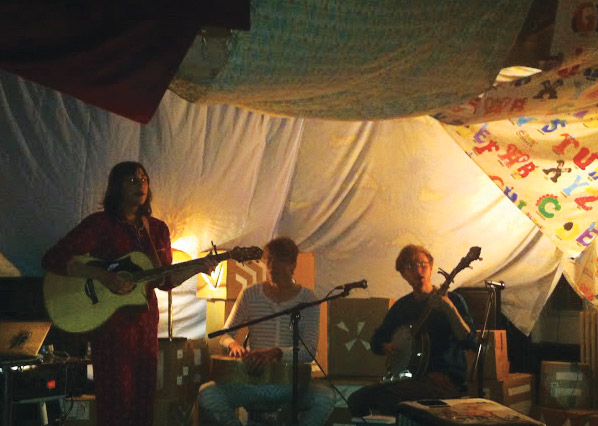It is four moves of the little hand until bedtime. You sit within your blanket fort and glance over your United Plushdom consisting of strategically fortified pillows, stuffed animals, and bed sheets. Your squire, Tedsworth Bear, informs you that the castle provisions of cookies, milk, and video games are healthy, and that no dragons have been sighted. All is well.
The childhood joy enveloped in a blanket fort is a special feeling that almost every child has aspired to attain. DF, a musical duo comprised of saxophonist Dustin Finer and light designer Daniel Freder, set out to recreate this ultimate childhood memory by staging a whole concert within the halls of an enormous blanket fort. The result was a unique experience that recalled cherished memories—all while donating dozens of blankets to charity.
Within the confines of the part-library, part-bookstore La Passe (1214 rue de la Montagne), DF—along with acoustic opener Brigitte Naggar—performed last Friday in what was easily a child’s dream come true. An epic mountain of Beanie-Babies guarded the entrance to the fort, immediately triggering a wave of nostalgia upon entering the venue. Past the parted entry curtains to the blanket fort was a massive, wooden room where the floor, ceiling, and walls were entirely covered in plush objects. From the nostalgic Disney, Garfield, and ABC-themed blankets to the warm, upright piano in the corner, the fort oozed of kid-power. Complementing the venue’s good vibes, the event staff handed out free popcorn for sharing among the mostly pajama-sporting concertgoers.
The atmosphere was perfectly set for Naggar’s acoustic set. Performing soft indie tunes alongside comical renditions of modern R&B and hip-hop songs, Naggar put on an intimate set that constantly engaged with the audience. Upon request, the crowd accompanied numerous tunes—ranging from Bill Withers’ somber “Ain’t No Sunshine” to a hilarious acoustic cover of Kendrick Lamar’s “Bitch, Don’t Kill My Vibe”—with singing, snaps, and claps. While participation from the audience is standard concert procedure, the confines of the blanket fort allowed for a more intimate feel to the show as the faces and voices of both crowd and artist were easily discernable. The intimacy of the venue, however, let musical mess-ups easily seep through. Though Naggar frequently forgot lyrics, cut songs halfway, and cracked her voice, these mistakes only furthered the feeling of intimacy that permeated the blanket fort, as the crowd laughed and cheered them away in solidarity.
After the simple and sparse acoustic set by Naggar, DF’s set—with its numerous sound interfaces, light boxes, and projections—established a tone of a ‘grown-up’ childhood that lingered as they began to play pieces that drew from classical, jazz, and minimal music. Delivering an “interactive space where sound and light influence one another,” DF carefully matched the swaying moods of each piece with an accompanying light show.
Their illumination, however, was far from ordinary: Orange lights inside cardboard boxes carved with intricate patterns showered the blanket fort in incandescent waves. Since most of DF’s songs follow a general pattern of ascension—starting very slow and building up to an epic climax—the varying intensities of light nicely complemented the music.
Lone saxophonist Dustin Finer packed the punch of a sax quartet with a quarter of the people by using his looper. It was amazing to see so many layers of harmonies, rhythms, and effects come from one source. At times, DF would abandon the sax to focus on more effects-driven pieces, but these proved to be slightly monotonous and often droned the same two chords for far too long. However, beautiful gems such as “Telesim” more than made up for this and cemented DF as a solid experiment into the modern realm of visual jazz.
DF and Brigitte were able to push the bounds of what a traditional concert can be, all while helping the community by donating the blankets from the fort to the charity Renaissance Quebec.









